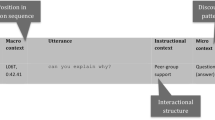Abstract
Described in this chapter is how science teachers can use communication models to guide their design and implementation of science lessons for ELLs. Taking the form of diagrams that visually depict communicative processes underlying science content instruction, communication models provide instructors with an intuitive and accessible way of critically examining content-language integrated learning. More specifically, we show how two models – repair-and-accommodation and 5R – help science teachers with limited linguistic expertise infuse content learning with additional language acquisition.
Access this chapter
Tax calculation will be finalised at checkout
Purchases are for personal use only
Similar content being viewed by others
References
Austin, J. L. (1962). How to do thing with words. Oxford, UK: Clarendon Press.
Bransford, J. D., Brown, A. L., & Cocking, R. R. (2002). How people learn: Brain, mind, experience, and school. Washington, DC: National Academy Press.
Echevarria, J., Vogt, M., & Short, D. J. (2003). Making content comprehensible for English language learners: The SIOP model (2nd ed.). Boston, MA: Pearson Allyn & Bacon.
Ellis, R. (1991). Second language acquisition and language pedagogy. Bristol, PA: Multilingual Matters Ltd.
Gee, J. P. (2002). Literacies, identities, and discourses. In M. J. Schleppegrell & M. Cecilia Colombi (Eds.), Developing advanced literacy in first and second languages (pp. 159–175). Mahwah, NJ: Lawrence Erlbaum Associates.
Gee, J. P. (2008). A sociocultural perspective on opportunity to learn. In P. A. Moss, D. C. Pullin, J. P. Gee, E. H. Haertel, & L. J. Young (Eds.), Assessment, equity and opportunity to learn (pp. 76–108). New York, NY: Cambridge University Press.
Giles, H., & Wiemann, J. M. (1987). Language, social comparison, and power. In C. R. Berger & S. H. Chaffee (Eds.), The handbook of communication science (pp. 350–384). Newbury Park, CA: Sage.
Glass, R., & Oliveira, A. W. (2014). Science language accommodation in elementary school read-alouds. International Journal of Science Education, 36, 577–609.
Hatch, E. (1983). Simplified input and second language acquisition. In R. Andersen (Ed.), Pidginization and creolization as language acquisition (pp. 64–86). Newbury, CA: House Publishers.
Hoadley, U. (2007). The reproduction of social class inequalities through mathematics pedagogies in South African primary schools. Journal of Curriculum Studies, 39(6), 679–706.
Jefferson, G. (1987). On exposed and embedded correction in conversation. In G. Button & J. R. E. Lee (Eds.), Talk and social organization (pp. 86–100). Clevedon, UK: Multilingual Matters.
Krashen, S. (1985). The input hypothesis: Issues and implications. New York, NY: Longman.
Leach, J., Yates, S., & Scanlon, E. (2008). Models of science communication. In R. Holliman, E. Whitelegg, E. Scanlon, S. Smidt, & J. Thomas (Eds.), Investigating science communication in the information age: Implications for public engagement and popular media (pp. 128–146). New York, NY: Oxford University Press.
Leggo, C. (1998). Living un/grammatically in a grammatical world: The pedagogic world of teachers and students. Interchange, 29, 169–184.
Lemke, J. L. (1990). Talking science: Language, learning and values. Norwood, NJ: Ablex.
Lemke, J. L. (2002). Multimedia semiotics: Genres for science education and scientific literacy. In M. J. Schleppegrell & M. Cecilia Colombi (Eds.), Developing advanced literacy in first and second languages (pp. 21–44). Mahwah, NJ: Lawrence Erlbaum Associates.
Lemke, J. l. (2004). The literacies of science. In E. W. Saul (Ed.), Crossing borders in literacy and science instruction (pp. 33–67). Arlington, VA: NSTA Press.
NGSS Lead States. (2013). Next Generation Science Standards: For states, by states. Washington, DC: The National Academies Press.
Oliveira, A. W., Meskill, C., Judson, D., Gregory, K., Rogers, P., Imperial, C. J., & Casler-Failing, S. (2015). Language repair strategies in bilingual tutoring of mathematics word problems. Canadian Journal of Science, Mathematics and Technology Education, 15, 102–115.
Pomerantz, A., & Fehr, B. J. (2011). Conversation analysis: An approach to the analysis of social interaction. In v. Dijk (Ed.), Discourse studies: A multidisciplinary introduction (2nd ed., pp. 165–190). Thousand Oaks, CA: Sage Publications.
Schegloff, E. A. (2000). When “others” initiate repair. Applied Linguistics, 21, 205–243.
Searle, J. (1969). Speech acts. Cambridge, UK: Cambridge University Press.
Street, R. L., & Giles, H. (1982). Speech accommodation theory: A social cognitive approach to language and speech behavior. In M. Roloff & C. R. Berger (Eds.), Social cognition and communication (pp. 193–226). Beverly Hills, CA: Sage.
University of Colorado. (2015). PhET interactive simulations. Retrieved from http://phet.colorado.edu/en/simulations/category/chemistry
Weinburgh, M. H., & Silva, C. (2012). An instructional theory for english language learners: The 5R model for enhancing academic language development in inquiry-based science. In B. J. Irby, G. Brown, & R. Lara-Alecio (Eds.), Handbook of educational theories (pp. 291–301). Charlotte, NC: Information Age Publishing.
Weinburgh, M. H., Silva, C., Malloy, R., Marshall, J., & Smith, K. (2012). A science lesson or language lesson? Using the 5R instructional model during a unit on soil erosion. Science and Children, 49(9), 72–76.
Author information
Authors and Affiliations
Corresponding author
Editor information
Editors and Affiliations
Rights and permissions
Copyright information
© 2019 Springer Nature Switzerland AG
About this chapter
Cite this chapter
Oliveira, A.W., Weinburgh, M.H. (2019). Using Communication Models to Teach ELLs Science. In: de Oliveira, L.C., Obenchain, K.M., Kenney, R.H., Oliveira, A.W. (eds) Teaching the Content Areas to English Language Learners in Secondary Schools. English Language Education, vol 17. Springer, Cham. https://doi.org/10.1007/978-3-030-02245-7_16
Download citation
DOI: https://doi.org/10.1007/978-3-030-02245-7_16
Published:
Publisher Name: Springer, Cham
Print ISBN: 978-3-030-02244-0
Online ISBN: 978-3-030-02245-7
eBook Packages: EducationEducation (R0)




